Imagine automating complex tasks, predicting trends, and working with your team in real time—without needing years of experience. Today’s spreadsheet tools are much more than simple calculators. This advanced Excel tutorial for beginners will show you how to use them to their fullest.
With features like AI-powered Copilot and seamless cloud integration in Excel 365, even beginners can do what used to need special training.
Those days of manually sorting data or struggling with formulas are over. Microsoft’s latest updates let you analyze patterns instantly. You can also generate dynamic charts with natural language commands and share work securely across devices.
Whether you’re budgeting for a small business or preparing reports for executives, these tools turn tedious tasks into strategic opportunities.
By mastering these Excel basics for beginners, you’ll save hours each week. You’ll also become the go-to problem solver in your workplace. Ready to transform how you work with numbers?
Key Takeaways
- Modern Excel features like Copilot simplify complex tasks through AI assistance
- Cloud collaboration in Excel 365 enables real-time teamwork across locations
- Natural language commands let beginners create charts and formulas effortlessly
- Automation tools reduce manual data entry and calculation errors
- Mastering foundational skills opens doors to career advancement opportunities
Why Learn Advanced Excel Skills?

Learning Excel can turn simple spreadsheets into powerful tools for making decisions. It’s not just for basic math anymore. Advanced skills help you analyze sales trends and manage budgets more efficiently. This way, you can work smarter, not harder.
Excel skills also open up new career paths and solve everyday work problems. Let’s dive into how mastering Excel can boost your career and tackle common challenges at work.
Career Growth Through Spreadsheet Mastery
87% of business analysts say Excel is essential for their job, according to W3Schools. Having these skills can lead to opportunities in many fields:
- Finance pros can create complex budget models easily
- Marketing teams can track campaign success in real-time
- Operations managers can improve supply chain management
“Employees with advanced Excel skills earn 22% more on average than basic users.”
Breaking Through Beginner Barriers
New users often face challenges like:
- Time-consuming manual data entry
- Error-prone calculations
- Limited reporting capabilities
Power Query makes data imports easier, and dynamic arrays help avoid formula errors. These excel tips and tricks make work more efficient.
Excel in Action: Real Business Solutions
Advanced Excel features lead to real results:
| Challenge | Basic Approach | Excel Solution |
|---|---|---|
| Sales Analysis | Manual sorting | PivotTable reports |
| Inventory Tracking | Paper checklists | Conditional formatting alerts |
Financial analysts can finish quarterly reports 40% faster with excel for data analysis. Marketing teams can merge customer data from different sources in minutes using XLOOKUP.
Excel Interface Fundamentals
Learning Excel’s interface can boost your productivity right away. It’s like having a control center for your spreadsheets. Every tool has a role, but customizing them makes you a pro. Let’s dive into three essential skills to change how you work with spreadsheets.

Quick Access Toolbar Customization
Your Quick Access Toolbar is your personal command center. Right-click on any tool, like Text to Columns or Format Painter, and choose “Add to Quick Access Toolbar.” Here’s a tip:
- Group similar actions together
- Use separators to keep things tidy
- Save and transfer your setup to other devices
Ribbon Navigation Strategies
The Analyze Data feature is hidden under the Home tab by default. Create a custom “Analytics” tab for financial modeling:
| Default Tabs | Custom Tab Benefits | Key Features |
|---|---|---|
| General tools | Workflow-specific | Macro buttons |
| Basic formatting | Faster access | Custom shortcuts |
| Scattered functions | Task-focused | Template integration |
Worksheet Management Techniques
Right-click on sheet tabs to:
- Rename with Shift + F2
- Color-code project phases
- Group sheets for bulk edits
Use Ctrl + Page Up/Down to switch between datasets. Many beginners miss the right-click menus, which have 80% of the daily-use features.
Data Entry Mastery
Learning to master data entry in Excel can turn tedious typing into smart automation. With the right tools, you can cut down errors by 60%+ and speed up repetitive tasks. Let’s dive into three key features that make Excel a great ally for data entry.

Smart Autofill Patterns
Excel’s autofill handle does more than just copy values. Drag the bottom-right corner of any cell to:
- Extend number sequences (1, 2, 3…)
- Repeat custom lists (Q1, Q2, Q3…)
- Fill formatted dates or currency patterns
To create personalized lists, go to File > Options > Advanced > Edit Custom Lists. This is great for product codes or location abbreviations you use often.
Flash Fill Magic (Ctrl + E)
This AI tool automatically formats data based on patterns you show it. To split full names into first/last columns:
- Type the first name manually in column B
- Press Ctrl + E to auto-fill the rest
- Do the same for last names in column C
Microsoft’s studies show Flash Fill cuts address formatting time by 83% for shipping databases.
Data Validation Best Practices
Stop spreadsheet errors before they start with controlled input rules. Use Data > Data Validation to:
| Validation Type | Use Case | Error Message Example |
|---|---|---|
| Whole Numbers | Age columns | “Enter value between 0-120” |
| List from Range | Department codes | “Select valid department” |
| Date Range | Project timelines | “Date must be in 2024” |
Use validation with conditional formatting to spot suspicious entries in red before you finalize your data.
Essential Formulas Every Beginner Should Know
Learning core Excel formulas makes spreadsheets more than just grids. They become powerful tools for data. These basic functions help with calculations, reduce mistakes, and reveal hidden insights. Let’s look at three key formula types that are the foundation of efficient spreadsheet work.
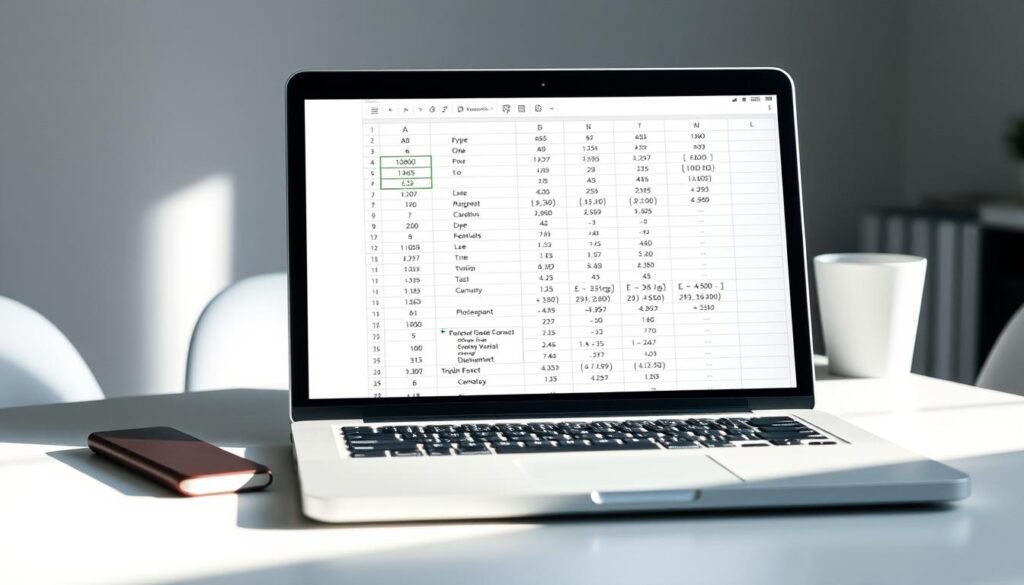
SUM/AVERAGE/COUNT Variations
Basic math functions cover 80% of daily spreadsheet tasks. =SUM() adds numbers, while =AVERAGE() and =COUNT() offer quick analysis:
| Function | Use Case | Example |
|---|---|---|
| SUMIF | Add sales over $500 | =SUMIF(B2:B100,”>500″) |
| AVERAGEA | Include text as zeros | =AVERAGEA(D2:D50) |
| COUNTA | Count non-blank cells | =COUNTA(A2:A1000) |
Pro Tip: Use Alt + = to auto-insert SUM formulas for adjacent number ranges.
VLOOKUP Basics
This vertical lookup wizard finds data across tables. It uses four arguments:
=VLOOKUP(lookup_value, table_array, column_index, [range_lookup])
For inventory management, it’s great for finding product prices by ID. Always lock ranges with F4 ($ signs) when copying. Though it only searches rightward, VLOOKUP is essential for basic data matching.
IF Statement Logic Structure
Create decision-making formulas with this pattern:
- Define condition (e.g., sales > $1000)
- Specify “True” result (5% commission)
- Set “False” result (2% commission)
Example: =IF(B2>1000, B2*0.05, B2*0.02). For tiered calculations, use multiple IF statements but keep them under three for clarity.
Download our practice sheet to try these formulas with sample sales data. You’ll work on totals, match product details, and figure out commissions in real-world scenarios.
Power Functions for Data Analysis
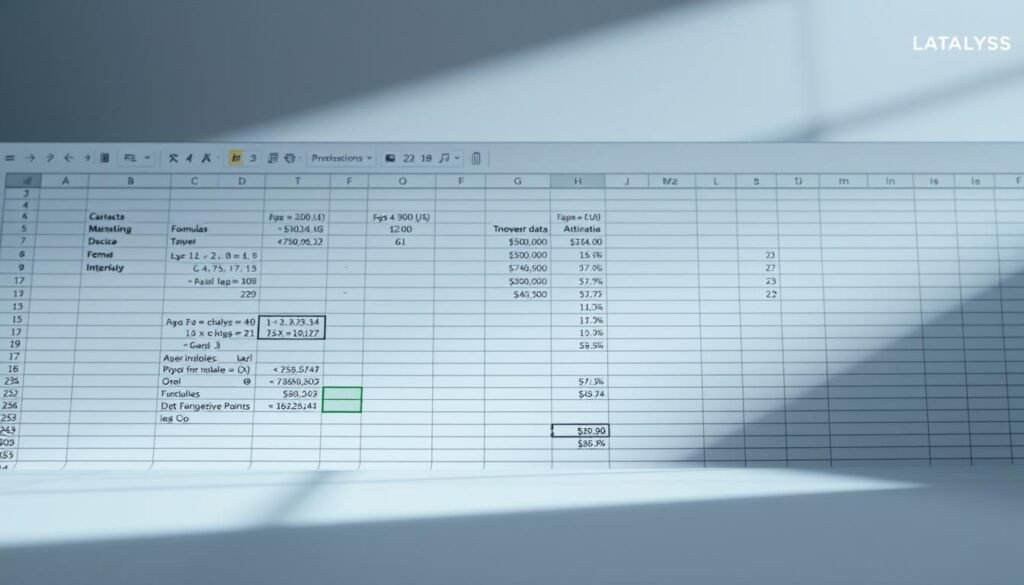
Excel’s power functions turn simple data into valuable insights. They make analyzing big datasets quick and accurate. Let’s look at three key features that boost your Excel for data analysis skills.
XLOOKUP vs VLOOKUP: Choosing the Right Tool
XLOOKUP is now Excel’s top choice for finding data. It looks left and right and handles mistakes well. Here’s a table to help you pick the right function for your needs:
| Feature | XLOOKUP | VLOOKUP |
|---|---|---|
| Search Direction | Left-to-right & right-to-left | Left-to-right only |
| Error Handling | Customizable error messages | #N/A errors |
| Column Insertion | Unaffected | Breaks formulas |
“XLOOKUP’s bidirectional search capability reduces formula complexity by 40% in typical business scenarios.”
INDEX-MATCH: The Flexible Alternative
Use INDEX and MATCH for precise searches. They work well with changing data, unlike VLOOKUP. For example:
- Find employee names using ID numbers
- Pull pricing data from irregular tables
- Match multiple criteria across sheets
SUMIFS/COUNTIFS: Multi-Layered Analysis
These functions help track specific conditions. SUMIFS adds totals with filters, and COUNTIFS counts entries. Think about analyzing Q3 sales data:
- Sum all orders from the Northeast region
- Count transactions above $500
- Exclude canceled orders automatically
These tools work together for detailed reports. Try mixing them with XLOOKUP for advanced Excel for data analysis skills.
Formatting Like a Pro
Professional spreadsheet formatting turns raw data into clear insights. By mastering these excel tips and tricks, you’ll make documents that show trends clearly. These documents will also look the same across teams. Let’s look at three formatting tricks that make basic spreadsheets into polished reports.
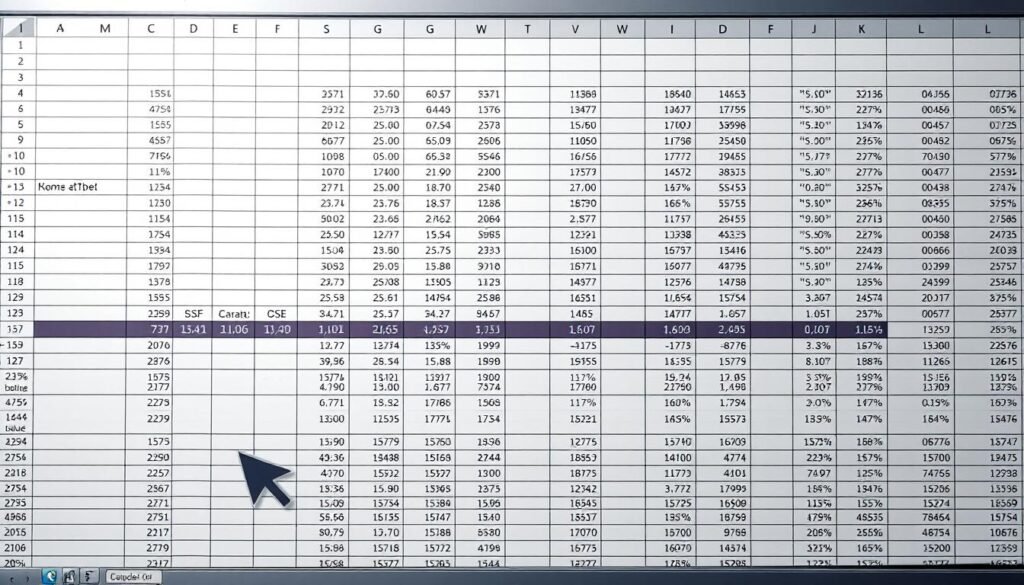
Conditional Formatting Presets
Excel’s conditional formatting highlights important data points automatically. Use color scales to make heat maps for sales or inventory. The data bars preset lets you compare values easily without charts. Here’s how to do it:
- Select your data range
- Choose Home > Conditional Formatting
- Pick icon sets for status tracking
Table Formatting Advantages
Turn data ranges into official Excel tables (Ctrl+T) for automatic styling and filtering. Microsoft suggests using tables for:
| Feature | Regular Range | Formatted Table |
|---|---|---|
| Auto-expanding | Manual | Yes |
| Header visibility | Scroll-dependent | Frozen |
| Style updates | Cell-by-cell | Global |
Cell Style Customization
Create unique formats using the Cell Styles gallery. Save your own:
- Font choices
- Border patterns
- Fill colors
Right-click any style and select Modify to fit your company’s colors. Pro tip: Use Format Painter (Ctrl+Shift+C) to copy styles between workbooks.
Data Organization Strategies
Learning Excel basics is key to turning messy spreadsheets into organized databases. Good data organization saves a lot of time and avoids mistakes. Here are three professional ways to keep your data clean.
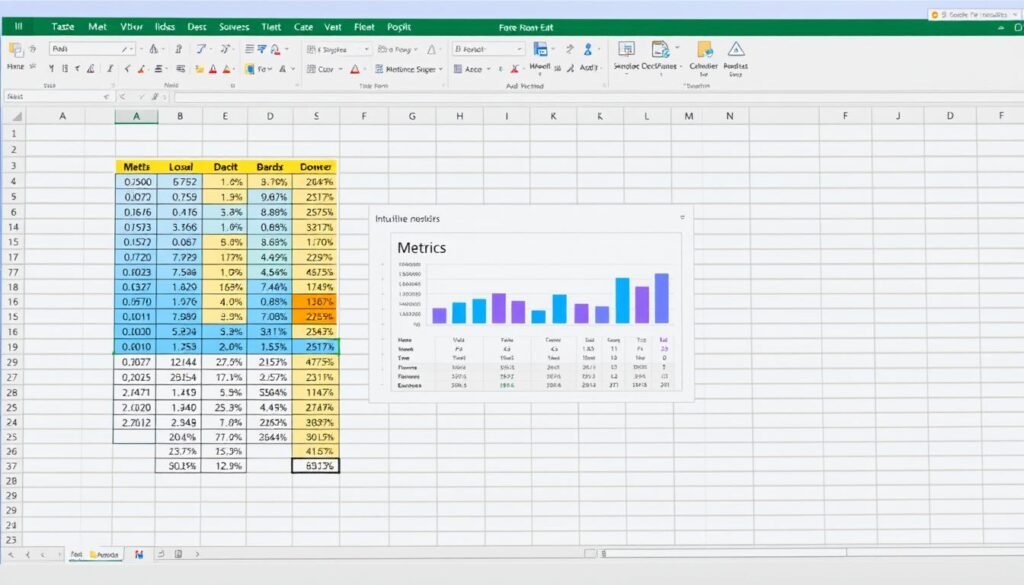
Sorting With Custom Lists
Excel’s basic sort is good for simple tasks. But, custom lists are better for complex sequences. You can make lists for things like fiscal calendars or sales areas:
- Navigate to File > Options > Advanced
- Click “Edit Custom Lists” under General options
- Input your sequence (Q1-Q4, product categories, etc.)
This makes your data sort in your preferred order every time.
Advanced Filtering Techniques
There’s more to filtering than basic options. Here are some advanced ones:
| Filter Type | Best For | Shortcut |
|---|---|---|
| Date Ranges | Financial quarters | Ctrl+Shift+L |
| Top 10 Items | Performance analysis | Alt+A+Q |
| Custom Criteria | Specific text patterns | Alt+D+F+F |
You can use AND/OR logic to filter data precisely.
Remove Duplicates Effectively
Excel has a tool to remove duplicates, keeping your CRM clean:
- Select your data range
- Choose Data > Remove Duplicates
- Check columns with unique data
Always back up your data before removing duplicates. For finding partial matches, use Conditional Formatting > Highlight Duplicates first.
Pivot Table Basics
Learning pivot tables is a big step up for anyone using Excel for data analysis. These tools make it easy to summarize and explore big datasets. They help you find patterns without needing complicated formulas. Let’s see how they work with a sales data example.
Creating Your First Pivot Table
Begin with data that has clear headers. Here’s how to start:
- Select any cell in your dataset
- Go to Insert > PivotTable
- Drag fields to Rows, Columns, and Values areas
For sales analysis, put “Product Category” in Rows and “Revenue” in Values. Excel will sum your numbers for you, giving you a quick view.
Value Field Settings
Right-click on a number in your pivot table to unlock its full power:
- Change summaries from Sum to Average
- Show values as percentages of totals
- Compare year-over-year growth
In our example, setting “Revenue” to % of Grand Total shows each category’s share right away.
Interactive Filtering With Slicers
Slicers make your reports interactive. Here’s how to add them:
- Click inside your pivot table
- Navigate to PivotTable Analyze > Insert Slicer
- Choose fields like Region or Quarter
These visual filters let users see regional or seasonal trends easily. You can link slicers to different tables for a unified dashboard.
With these Excel for data analysis skills, you can turn numbers into useful insights. Try making dashboards that show regional performance and update automatically with new data.
Chart Creation Essentials
Excel’s chart tools turn numbers into insights easily. They help in showing sales trends or budget forecasts. Microsoft’s Analyze Data feature suggests chart types, making it a top excel tip and trick for new users.
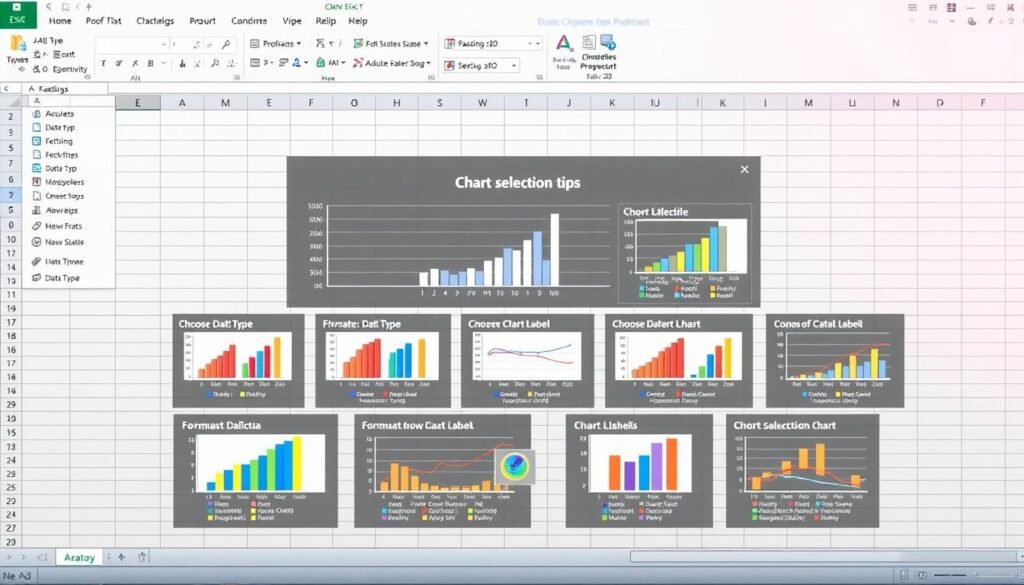
Choosing the Right Chart Type
Choosing the right visuals depends on your data’s purpose. Here’s a quick guide:
- Comparisons: Use column/bar charts for side-by-side metrics
- Trends: Line charts for tracking over time
- Proportions: Pie/doughnut charts for showing percentages
For complex data, Excel’s Recommended Charts tool helps. It suggests formats based on your data, saving time.
Dynamic Chart Formatting
Make charts update automatically with these excel tips and tricks:
- Turn data ranges into Excel Tables (Ctrl+T)
- Use named ranges with OFFSET formulas
- Apply conditional formatting to chart elements
Dynamic charts update with new data, keeping your dashboards current. Use Theme Colors for consistent branding in presentations.
Sparklines for Data Trends
Sparklines are small charts in cells, great for showing trends. To add sparklines:
- Select your data range
- Navigate to Insert > Sparklines
- Choose line, column, or win/loss format
Customize sparkline colors and markers in the Sparkline Tools tab. They’re perfect for financial reports where space is tight but trends are key.
Time-Saving Keyboard Shortcuts

Excel power users know the real magic happens when fingers stay on the keyboard. These shortcuts slash spreadsheet navigation time by 40% (W3Schools data) while reducing mouse dependency. Let’s break down three categories of essential keyboard commands that turn tedious tasks into quick actions.
Navigate Spreadsheets Like a Pro
- Ctrl + Arrow keys: Jump to edge cells in data regions
- Ctrl + Home/End: Instantly reach worksheet start/end
- Alt + Page Up/Down: Scroll horizontally without touching mouse
Master Cell Selection Techniques
- Shift + Space: Select entire row with one hand
- Ctrl + Space: Highlight entire column instantly
- Ctrl + Shift + L: Toggle filters without ribbon hunting
Formula Debugging Shortcuts
- Ctrl + [: Trace precedent cells in complex formulas
- F2: Edit directly in cell instead of formula bar
- Ctrl + Shift + U: Expand formula bar for long equations
For continuous learning, keep our printable cheat sheet handy. It features 15 shortcuts ranked by time-saving impact – perfect for sticking near your workstation. Pro tip: Start with 3 shortcuts daily, then gradually build muscle memory.
Data Cleaning Techniques
Learning to clean data makes messy spreadsheets useful. Whether for reports or sales analysis, three tools are key. They help you learn Excel step by step and keep your data top-notch.
Split Data Like a Pro With Text-to-Columns
Excel’s Text-to-Columns wizard fixes mixed-up data fast. Here’s how to split it:
- Select the column with mixed data (like “City, State”)
- Go to Data > Text to Columns
- Choose Delimited > Next
- Pick your separator (comma, space, etc.)
This method is great for splitting addresses, names, or codes. For more complex cases, Power Query’s “Split Column by Delimiter” is perfect.
Eliminate Hidden Characters With TRIM & CLEAN
Hidden spaces and symbols mess up calculations. Use these formulas:
=TRIM(A1)removes leading/trailing spaces=CLEAN(A1)deletes non-printable characters
For cleaning many cells at once, use =CLEAN(TRIM(A1)) in a helper column.
Automate Error Detection
Excel’s error checking tools (Formulas > Error Checking) find common mistakes:
| Error Type | Manual Fix | Power Query Solution |
|---|---|---|
| #VALUE! Errors | Audit formulas | Replace errors in transform |
| Duplicate Rows | Remove manually | Auto-deduplicate |
| Date Formats | Format cells | Locale-aware parsing |
Power Query users can right-click column headers to “Replace Errors”. This ensures data consistency when learning Excel step by step.
Introduction to Macros
Excel macros make repetitive tasks easy by turning them into one-click actions. They help with formatting, calculations, and organizing data. You don’t need to know how to code to use them. Microsoft has rules to keep macros safe, asking you to allow them in files you don’t trust.
Recording Your First Macro
Here’s how to start automating:
- Enable the Developer tab via File > Options > Customize Ribbon
- Click Record Macro and name your automation
- Do your task as usual – every action is recorded
- Stop recording and save as .xlsm file type
Try out your macro right away from the Macros dialog box. This makes it easy for beginners to see how actions become code.
Assigning Macro Buttons
Here’s how to make macros easy to use:
- Right-click the Quick Access Toolbar > Customize
- Choose Macros from the command list
- Drag your macro to the toolbar for quick access
For those who use macros a lot, create custom Ribbon tabs. This makes it easier to find your macros during big projects.
Basic VBA Concepts
Enhance your macros with simple VBA edits:
- Press Alt+F11 to open the VBA Editor
- Find modules with your recorded code
- Change values between Sub and End Sub commands
Always check where macros come from before using them. Microsoft suggests keeping macro security at “Disable with Notification” for safety. As you get better, you’ll make macros that work with different data.
Collaboration Features
Today’s workplaces need teamwork to work smoothly. Excel’s tools make spreadsheets interactive. With Microsoft 365, many can edit at once, which is great for team projects.
Track Changes for Transparent Editing
Turn on Track Changes under Review > Track Changes to see who’s editing what. This feature:
- Highlights cell edits with user-specific colors
- Stores revision history for 30 days
- Shows exact modification times and authors
Financial teams love it for tracking budget changes. Always save a copy before starting to edit.
Comments vs Notes: When to Use Each
| Feature | Comments | Notes |
|---|---|---|
| Visibility | Visible in margins | Hidden until hovered |
| Use Case | Team discussions | Private reminders |
| Threading | Supports replies | Single annotation |
Comments are for team talks about data. Notes are for personal notes, like explaining formulas.
Shared Workbook Safety Measures
When using Share Workbook under the Review tab:
- Set update intervals to 15-30 minutes
- Use File > Info > Version History weekly
- Resolve conflicts through “Accept/Reject Changes”
Keep shared files simple to avoid editing issues. Beginners should practice with dummy data first.
Template Creation Guide
Learning to make Excel templates can save you a lot of time. It helps keep your work consistent. You can use templates for budgets, reports, or trackers. Microsoft’s Create template gallery has great examples for excel basics for beginners to learn from.
Building Custom Templates
Here’s how to make reliable templates:
- Design placeholder cells for user input (highlighted in yellow)
- Lock critical formulas using Format Cells > Protection
- Add instructional comments for template users
Always test your templates with sample data first. Use dropdown lists via data validation to avoid mistakes.
Protecting Template Structure
Keep your work safe in three ways:
- Select cells users should edit (Ctrl + Click multiple ranges)
- Right-click > Format Cells > Uncheck “Locked”
- Enable sheet protection with a password under Review tab
This way, you avoid losing formulas by mistake but let users enter data.
Sharing Templates Securely
Share your templates safely with these tips:
- Store in OneDrive for team access with edit permissions
- Use PDF copies for external sharing without formulas
- Password-protect sensitive financial models
For public templates, remove personal data and test links before sharing on Microsoft’s gallery.
Troubleshooting Common Errors
Formula errors can really slow you down in Excel. But, with the right steps, you can fix them quickly. Let’s look at three common problems and how to solve them.
#VALUE! and #REF! Solutions
The #VALUE! error happens when formulas mix text and numbers wrong. Look for:
- Hidden spaces in cells (use TRIM function)
- Date formats that don’t match calculations
- Wrong parentheses in complex formulas
#REF! errors mean cell references are broken. Quick fix: Press Ctrl+Z right away if you see the error. For ongoing problems, use Excel’s Trace Dependents tool (Formulas tab > Formula Auditing).
Circular Reference Detection
Excel alerts you to circular references with a status bar message. Here’s what to do:
- Go to Formulas > Error Checking > Circular References
- Check the cell addresses listed
- Fix the loop by changing one formula’s reference
Pro tip: Circular references can show up in complex models. Make sure to enable iterative calculation only if you mean to use it (File > Options > Formulas).
Formula Evaluation Steps
Excel’s Formula Evaluator helps you debug step-by-step:
- Select the cell with the tricky formula
- Go to Formulas > Evaluate Formula
- Click Evaluate over and over to see each step
This tool is great for complex IF statements and references across sheets. Remember: Keep pressing Evaluate until you find where the error happens. That’s where you start fixing it.
Conclusion
This advanced Excel tutorial has given you the basics to turn data into useful insights. You’ve learned how to use VLOOKUP and create macros. Now, you can move from simple spreadsheets to advanced data analysis.
Excel 365’s AI feature makes finding patterns easier. This lets you make better decisions without getting bogged down in numbers.
W3Schools helps you track your progress in Excel skills. Use these skills for real tasks, like analyzing sales or budgeting. Practice files make learning XLOOKUP and formatting easier.
Keep learning about Excel’s new features, like dynamic formulas and Power Query. Check out Microsoft’s support site for updates. Or, get certified in Excel through LinkedIn Learning.
Ready to put your skills to the test? Download the workbook that comes with this guide. Start making dashboards that tell stories with numbers.
FAQ
How long does it take to learn advanced Excel as a beginner?
With focused practice using Excel 365’s AI-powered Copilot, most learners achieve functional proficiency in 20-30 hours. Our advanced Excel tutorial for beginners accelerates learning through hands-on projects like sales analysis dashboards and inventory templates.
What’s the fastest way to clean messy data in Excel?
Combine Power Query for automated transformations with Text-to-Columns (Alt+A+E) and TRIM/CLEAN functions. For CRM data hygiene, use Remove Duplicates under Data Tools with backup versions through Excel 365’s automatic version history.
When should I use XLOOKUP instead of VLOOKUP?
Choose XLOOKUP for bidirectional searches and safer error handling. Microsoft recommends XLOOKUP for modern financial models, though VLOOKUP remains useful for simple left-to-right lookups in legacy spreadsheets.
How do I protect formulas while allowing data entry?
Use Review > Protect Sheet with password protection, first unlocking input cells through Format Cells > Protection. For shared templates, employ Excel 365’s Sensitivity Labels to control editing permissions in cloud-stored files.
Can Excel handle large datasets for data analysis?
While Excel 365 supports up to 1M+ rows through Power Pivot integration, use PivotTables with Group Field settings for optimal performance. For enterprise-scale data, combine with Microsoft Power BI using Get & Transform (Power Query) for seamless transitions.
What’s the best way to visualize sales trends over time?
Create dynamic line charts with date axis formatting, enhanced by conditional formatting heat maps. Add sparklines (Insert > Sparklines) for at-a-glance quarterly comparisons in sales commission reports.
How do I fix recurring #VALUE! errors in formulas?
Use Formulas > Evaluate Formula to step through calculations. Common fixes include replacing commas with semicolons in international settings, or using IFERROR with VLOOKUP to handle missing inventory codes.
Are macros safe for beginners to use in Excel?
Start with recorded macros for repetitive tasks like monthly report formatting. Always verify macro sources and enable Excel’s Trust Center protections. For shared workbooks, save as .xlsm and use Microsoft’s Digital Signatures for authentication.
How can multiple users collaborate on Excel files without conflicts?
Excel 365’s co-authoring feature through OneDrive allows real-time collaboration. Use Comments @mentions for task assignments and Track Changes (Review tab) with Accept/Reject for finalizing budget models.
What’s the most efficient way to learn Excel functions?
Our formula foundation approach combines function tutorials with downloadable practice sheets. Master SUMIFS for sales quotas first, then progress to INDEX-MATCH combinations. Use F9 to evaluate parts of complex formulas during learning.














